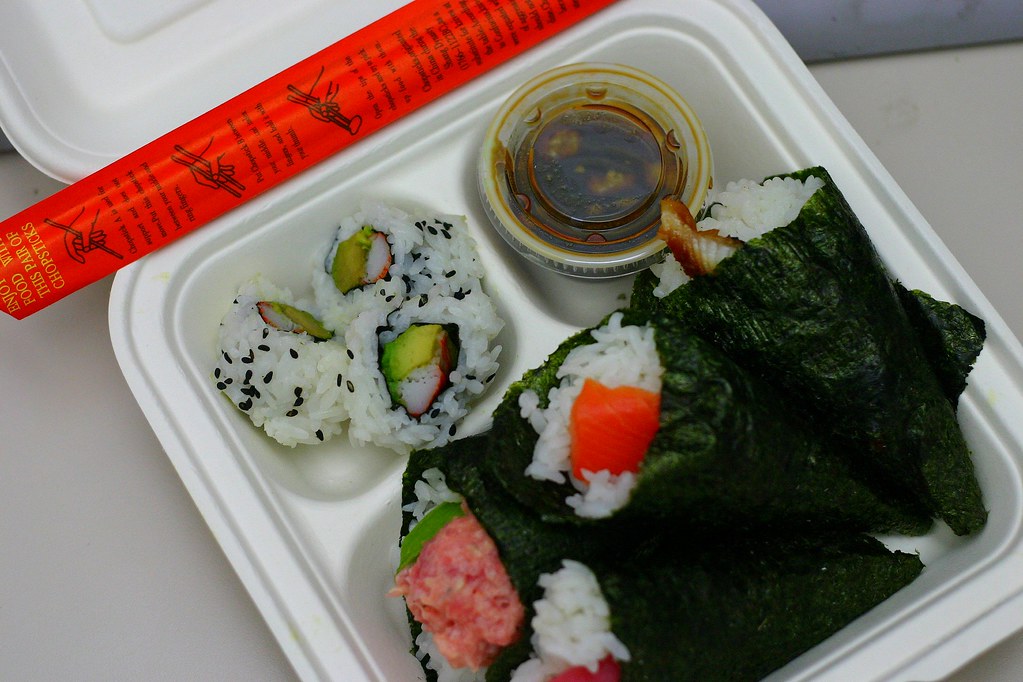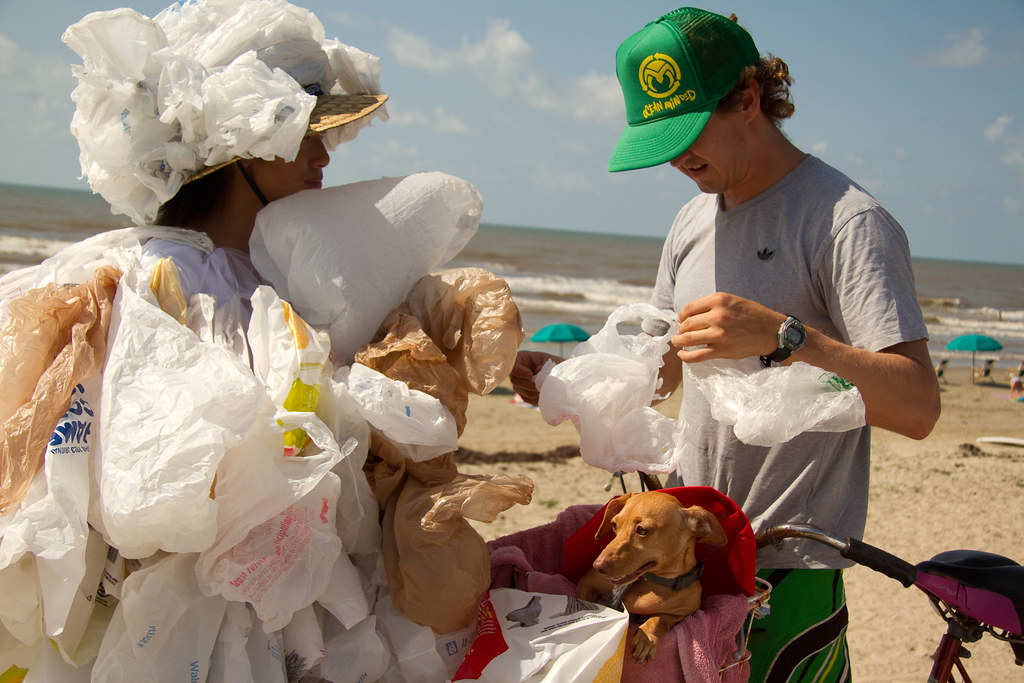摘譯自2017年7月10日ENS美國,加州,蒙特雷報導;姜唯編譯;蔡麗伶審校
認知到塑膠垃圾是海洋和淡水生態的最大威脅之一,美國19座水族館宣布組成「水族館保育聯盟」(Aquarium Conservation Partnership, ACP),聯手對抗塑膠污染進入湖泊海洋。
全美的水族館正逐漸淘汰免洗塑膠產品和包裝,並將嘗試說服消費者接受創新的替代品。
 2008年水族館販售的午餐壽司組合,仍使用一次性塑膠。圖片來源:Richard Masoner(CC BY-SA 2.0)
2008年水族館販售的午餐壽司組合,仍使用一次性塑膠。圖片來源:Richard Masoner(CC BY-SA 2.0)
「大眾信任水族館的專業,相信水族館的作為對海洋生態健康是重要的。」ACP發起者之一、加州蒙特利灣水族館(Monterey Bay Aquarium)執行董事Julie Packard表示。
透過全國性的「你我手中」(In Our Hands)推廣活動,ACP希望能從19間水族館的2000萬遊客甚至數百萬人的社群開始用創新替代品取代免洗塑膠。
今日所有ACP成員的場館已經不再提供塑膠吸管和一次性購物塑膠袋,並承諾在2020年前大幅減少或是完全不用塑膠飲料瓶,並在場館中展示創新替代品。
每年全世界有880萬噸塑膠進入海洋,等於每分鐘就有一卡車的塑膠被倒進海裡。
美國每人每年產生超過塑膠垃圾200磅的塑膠垃圾。如果繼續這樣下去,2025年進入海洋的塑膠垃圾量會成長一倍。
河川湖泊中的塑膠垃圾量跟海洋垃圾集中的環流處一樣多,甚至更多。今日密西根湖表面上,就飄著約10億顆塑膠顆粒。
 中途島的鳥類常誤食塑膠垃圾。圖片來源:Holly Richards/USFWS
中途島的鳥類常誤食塑膠垃圾。圖片來源:Holly Richards/USFWS
五大湖是地球上最大的淡水體,佔地表淡水總量21%,五大湖盆地棲息著超過3500種動植物。
芝加哥謝德水族館(Shedd Aquarium)執行長Bridget Coughlin博士指出:「每年有2200萬磅的塑膠流入密西根湖,等於是100個裝滿塑膠瓶的奧林匹克游泳池。」
今年夏天,ACP將聚焦喚起公眾意識和促進消費者行動,分享他們的成功減塑故事。同時這些水族館也和商業夥伴合作,展示免洗塑膠製品的創新替代品、加速新產品和材質的設計。
ACP成員也在想辦法從禮品店的商品、館內咖啡店和餐廳減少塑膠包裝。
此外,ACP也從地方、州和國家層級發聲支持減少塑膠進入自然水體的政策。除了贊助淨灘和教育活動,許多水族館也響應減用一次性塑膠袋和柔珠清潔用品的活動。
 水族館與環團聯手提倡關注塑膠垃圾議題。圖片來源:allison_b216(CC BY-NC 2.0)
水族館與環團聯手提倡關注塑膠垃圾議題。圖片來源:allison_b216(CC BY-NC 2.0)
U.S. Aquariums Battle Plastic Waste in Oceans, Lakes
MONTEREY, California, July 10, 2017 (ENS)
Stopping the flow of plastic pollution into oceans and lakes is the goal of a new partnership of 19 U.S. aquariums that say plastic waste is one of the gravest threats facing ocean and freshwater animals.
Aquariums from coast to coast are shifting away from single-use plastic products and packaging, and they will try to persuade consumers to build market demand for innovative alternatives to these plastics.
“The public trusts aquariums to do what’s right for the health of the ocean and for ocean wildlife,” said Julie Packard, executive director of the Monterey Bay Aquarium, a founding member of the new Aquarium Conservation Partnership, ACP.
Through the national “In Our Hands” campaign, the ACP hopes to empower their 20 million visitors and millions more in their communities to drive a national shift away from single-use plastic and toward innovative alternatives.
As of today, all ACP members have eliminated plastic straws and single-use plastic take-away bags from their premises.
The aquariums have committed to greatly reduce or eliminate plastic beverage bottles by December 2020 and showcase innovative alternatives to single-use plastic at their facilities.
About 8.8 million tons of plastic enters the ocean each year worldwide – roughly a dump truck full of plastic every minute of every day.
In the United States alone, plastic waste averages more than 200 pounds per person each year. If nothing changes, by 2025 the flow of plastic into the ocean is expected to double.
Plastic pollution in lakes and rivers has been found at levels as high, or higher, than in oceanic gyres that concentrate plastic trash.
Today, there are an estimated one billion plastic particles floating on the surface of Lake Michigan alone.
The Great Lakes are the largest surface freshwater system on the Earth, making up approximately 21 percent of the world’s supply of surface freshwater. Additionally, more than 3,500 species of plants and animals live in the Great Lakes basin.
Shedd Aquarium President and CEO Dr. Bridget Coughlin said, “Approximately 22 million pounds of plastic flows into the Great Lakes each year – in Lake Michigan alone, it is equivalent to 100 Olympic-sized swimming pools filled with bottles.”
This summer, the aquariums will focus on raising awareness and sparking consumer action, and sharing their own success stories to highlight the many ways they’ve cut back on single-use plastic in their operations.
They are working with business partners to showcase innovative alternatives to single-use plastic products, and will collaborate with vendors to accelerate design of new products and materials.
They are also finding ways to use less plastic packaging in gift store items, and scaling back on single-use plastic in their cafes and restaurants.
The aquariums are also using their collective voice at the local, state and national levels to support policies that reduce the flow of plastic pollution into the ocean, rivers and lakes. Beyond sponsoring clean-up events and education programs, many have backed successful efforts to stem the use of plastic shopping bags and plastic microbeads found in personal care products.